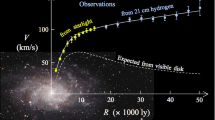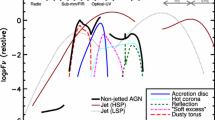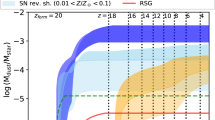Abstract
Imaging surveys indicate that galaxy interaction or merging plays an important role in triggering the quasar phenomenon. It is assumed that a luminous quasar is created in the center of a merger of virialized dark matter halos. The abundance and evolution of quasars are computed in the cold dark matter models. The comparison between observational data and model predictions is presented.
Similar content being viewed by others
References
Shaver, P. A., Wall, J. V., Kellermann, K. L. et al., Decrease in the space density of quasars at high redshift,Nature, 1996, 384: 439.
Efstathiou, G., Rees, M. J., High-redshift quasars in the cold dark matter cosmogony,MNRAS, 1988, 230: 5.
Nusser, A., Silk, J., Abundance and evolution of quasars in cold dark matter models,ApJ, 1993, 411: L1.
Robson, I.,Active Galactic Nuclei, New York: John Wiley & Sons, 1996.
Toomre, A., inEvolution of Galaxies and Stellar Populations (eds. Tinsley, B. M., Larson, R. B.), New Haven: Yale Observatory, 1977.
Sanders, D. B., Soifer, B. T., Elias, J. H. et al., Warm ultraluminous galaxies in the IRAS survey: The transition from galaxy to quasars?,ApJ, 1988, 328: L35.
Bahcall, J. N., Kirhakos, S., Saxe, D. H. et al., Hubble Space Telescope images of a sample of 20 nearby luminous quasars,ApJ, 1997, 479: 642.
Bond, J. R., Efstathiou, G., Cosmic background radiation anisotropies in universe dominated by nonbaryonic dark matter,ApJ, 1984, 285: L45.
Peebles, P. J. E.,Principles of Physical Cosmology, Newjersey: Princeton University Press, 1993.
Smoot, G. F., Bennett, C. L., Kogut, A. et al., Structure in the COBE DMR first-year maps,ApJ, 1992, 396: L1.
Saslaw, W. C.,Gravitational Physics of Stellar and Galactic Systems, Cambridge: Cambridge University Press, 1985.
Carlberg, R. G., Quasars evolution via galaxy mergers,ApJ, 1990, 350: 505.
Klypin, A., Holtzman, J., Primack, J. et al., Structure formation with cold plus hot dark matter,ApJ, 1993, 416: 1.
Wilson, A. S., Colberg, E. J. M., The difference between radio-loud and radio-quiet active galaxies,ApJ, 1998, 438: 62.
Kormendy, J., Richstone, D., Inward bound—The search for supermassive black holes in galactic nuclei,ARA & A, 1998, 33: 581.




